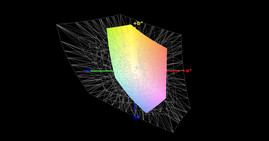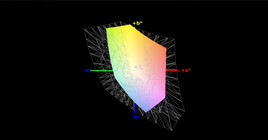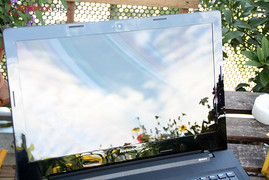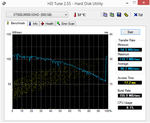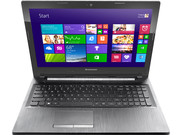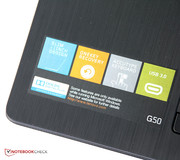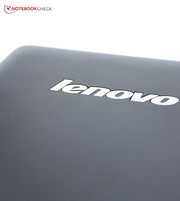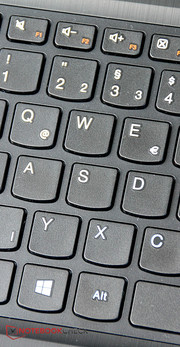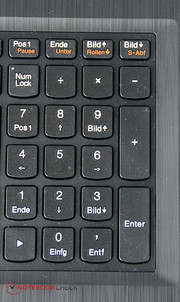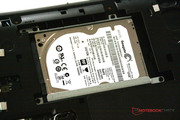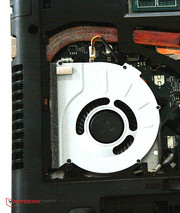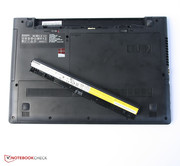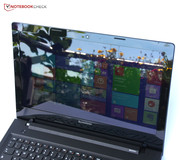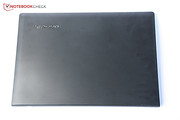Lenovo IdeaPad G50-45 Notebook Review Update

For the original German review, see here.
Buyers looking for a basic all-round laptop for office and multimedia applications nowadays will find countless potential devices for a low price. Besides laptops with an Intel Celeron and Pentium processor, there are also various AMD-based alternatives to choose from. Particularly those with the recently introduced Beema platform promise an excellent value-for-money ratio.
Lenovo is one of the first manufacturers that has a corresponding series in its lineup dubbed G50-45 (also sometimes called IdeaPad G50-45). The low-priced 15-inch laptop that only costs 270 to 450 Euros (~$349 to ~$582) depending on the configuration is very similar to the previously reviewed G50-70 based on Intel hardware (300 - 600 Euros, ~$388 - ~$776). Therefore, we will primarily focus on the new AMD A6-6310 in this report. It is an energy-efficient quad-core APU with an integrated Radeon R4 graphics core. With 4 GB of RAM and a 500 GB SSHD, our review sample's configuration adds up to around 370 Euros (~$479). Buyers who do not need Windows 8.1 can buy the same configuration for only 300 Euros (~$388). The G50-45 therefore competes with other low-cost laptops, such as Acer's Aspire E1-510 or Packard Bell's EasyNote TE69HW.
Considering the existing relationship with Lenovo's G50-70, we will not reexamine the casing, interfaces or input devices. The corresponding information can be found in the review of the previous test report.
Display
As is common in this category, the G50-45 relies on a medium-sized, 15.6-inch screen with a low 1366x768 pixels. That results in a pixel density of approximately 100 ppi. Not only does the sharpness of the content suffer, but also the available desktop area. Consequently, multitasking with complex software is only possible with massive restrictions. However, the rivals from Acer and Packard Bell do not have a higher resolution either.
The LED backlight achieves an at most middling brightness with a maximum average of 210 cd/m², which is, however, absolutely sufficient for using the laptop on the desk. Fortunately, the brightness does not decrease even further in battery mode. The homogeneous illumination of the entire screen has to be praised; distracting screen bleeding was hardly discovered even under closer examination.
| |||||||||||||||||||||||||
Brightness Distribution: 87 %
Center on Battery: 227 cd/m²
Contrast: 413:1 (Black: 0.55 cd/m²)
ΔE ColorChecker Calman: 11.12 | ∀{0.5-29.43 Ø4.78}
ΔE Greyscale Calman: 11.22 | ∀{0.09-98 Ø5}
41.78% AdobeRGB 1998 (Argyll 3D)
60.8% sRGB (Argyll 3D)
40.42% Display P3 (Argyll 3D)
Gamma: 2.12
CCT: 12270 K
As expected, the same TN screen is installed in the G50-45 as in the G50-70 (LG LP156WH3-TPSH) so that our measurements only deviate within the usual production tolerances. The contrast ratio of 413:1 is derived from the black level of 0.55 cd/m² and is roughly on par with the Aspire E1-510 (392:1) and EasyNote TE69HW (446:1). We would generally say that the image impression is satisfactory. A richer black would provide a stronger and more vivid presentation, but the result is acceptable in view of the price range.
However, the manufacturer's calibration of the screen is not really satisfactory. Particularly the much too high color temperature that is seen in a visible bluish cast has to be criticized here. The resulting DeltaE shifts can at least be reduced to some extent via a custom color profile (download link in the above graph). However, the user will inevitably have to accept the very limited color space (sRGB: 51%; AdobeRGB: 36%).
While the screen's limited brightness does not massively thwart indoor use, it makes using the laptop outdoors virtually impossible. Distracting reflections on the reflective surface cover the content even on cloudy days or in the shade. Lenovo regrettably does not optionally offer a matte screen for the G50-45.
A screen should offer as generous as possible viewing angles for movie nights with friends so that every viewer sees a high-contrast and undistorted picture. A TN screen will always fare worse than an IPS or PLS model owing to the underlying technology. However, certain differences are found in the single models. The LG screen installed here responds very sensitively to the slightest deviations particularly on the vertical plane. However, the lateral elbowroom is also massively limited. Vertical deviations beyond 30 degrees should be avoided when possible.
Performance
Although AMD has only marginally modified the Beema APU compared with the direct Kabini precursor, the new SoC generation promises impressive performance and efficiency improvements. With 1.8 to 2.4 GHz, the A6-6310 clocks up to 900 MHz faster than the former A4-5000 (1.5 GHz, no Turbo) - and that with a TDP classification of 15 watts and identical 28 nanometer production. Thus, the quad-core chip even outperforms the previous, considerably more power-guzzling A6-5200 premium model (2.0 GHz, 25 watts).
The integrated Radeon R4 graphics unit also exhibits a colossal leap in clock rate. The 128 shader units based on the GCN architecture can now reach a maximum frequency of 800 MHz. Furthermore, the extensive feature set including DirectX 11.2 support and AMD's proprietary Mantle API has to be highlighted.
Unfortunately, Lenovo only combines the APU with a 4 GB module in the DDR3-1600 standard. It would theoretically be possible to use a speedier DDR3-1866 memory. The decision seems logical considering the laptops low-cost design, although particularly the GPU's performance will likely suffer a bit. However, leaving out a second memory module is not a drawback because Beema only has a single-channel interface from the outset. Surprisingly, the manufacturer is very generous with the storage device; a capacious 500 GB hybrid hard drive (SSHD) is rare in this price category.
Processor
Owing to its four CPU cores, the A6-6310 makes a good impression particularly in well-parallelized benchmarks. The APU not only outruns Intel's entire Bay Trail lineup - represented in the form of the Pentium N3520 here - but marginally also the Core i3-4010U based on Haswell. Unfortunately, it cannot be clearly ascertained based on one single review sample whether the slight lag on the A8-6410 with an identical maximum clock rate is only due to measurement fluctuations, or a more careful selection (and thus a better use of the Turbo) of the A8.
While a frequency of approximately 2.0 GHz is reached in most multi-thread tests, the clock climbs to roughly 2.2 to 2.3 GHz in single-core load. That is enough to again defeat the Pentium N3520. However, the A6-6310 has to let all Haswell contenders pass. Owing to its considerably higher per-MHz performance, the Celeron 2957U clocked with just 1.4 GHz shows AMD's APU its limits. At least the described performance is also available in battery mode without losses.
Storage Devices
At first glance, the Seagate Laptop Thin SSHD might be seen as a conventional laptop hard drive - but this impression is deceiving. Owing to the additional large 8 GB flash storage cache, the drive can drastically increase accessing frequently used data. The advantages of this technology are only difficult to illustrate with the usual benchmark programs. The SSHD does not have a significant edge on a comparable HDD in either its access time (17.2 milliseconds) or its average transfer rate (90.2 MB/s) in HD Tune. That looks different in practice, but more about that in the following section.
System Performance
We will, however, first take a quick look at the synthetic benchmarks, and specifically PCMark 7 that provides a guide value for a system's application performance. Besides the processor's performance, particularly a swift storage device pays off here. Here, the G50-45 is the winner since the contenders in the forms of the EasyNote TE69HW and Aspire E1-572 can only fall back on a conventional hard drive. However, our review sample does not stand a chance against an array comprised of a Core i3 CPU and SSHD drive.
To what extent this difference is noticed in routine use depends on the single user's application profile. The laptop's reserves are absolutely sufficient for word processing and multimedia purposes. Furthermore, the system impresses with short boot and load times. The user will only sometimes want a bit more computing power when single cores are placed under particularly high load (installations, older programs, and games).
| PCMark 7 Score | 2555 points | |
| PCMark 8 Home Score Accelerated v2 | 2011 points | |
| PCMark 8 Creative Score Accelerated v2 | 2096 points | |
Help | ||
Graphics Card
The graphics card simply dubbed Radeon R4 by AMD is only the second-fastest Beema GPU at first glance - seeing that there is still the A8-6410 with its nominally stronger Radeon R5 core. Actually, the technical specs of both models, i.e. 128 GCN shaders, maximum 800 MHz, are exactly the same so that we do not expect any significant performance differences.
In fact, the A8 APU is 8% faster in 3DMark 11, which again could be due to the slightly better utilization of the Turbo. Regardless of this marginal difference, Beema offers a three to four times higher graphics performance than Intel's Bay Trail lineup and can even compete with the (usually more expensive) HD Graphics 4400. The HD 4400 first has a slight lead when combined with a dual-channel memory.
| 3DMark 03 Standard | 10908 points | |
| 3DMark 05 Standard | 6421 points | |
| 3DMark 06 Standard Score | 4046 points | |
| 3DMark Vantage P Result | 2506 points | |
| 3DMark 11 Performance | 795 points | |
| 3DMark Ice Storm Standard Score | 31319 points | |
| 3DMark Cloud Gate Standard Score | 2825 points | |
| 3DMark Fire Strike Score | 462 points | |
| 3DMark Fire Strike Extreme Score | 218 points | |
Help | ||
Gaming Performance
Unfortunately, the A6-6310 rarely manages to produce high frame rates with its comparatively strong GPU even in games. Limited by the low TDP classification, the CPU clock often drops below its base speed of 1.8 GHz when the processor and graphics card are loaded simultaneously. Unfortunately, we cannot say whether this is also true for the graphics unit clock rate due to the lack of suitable tools in the test. Ultimately, only a few games from recent years can be played smoothly using low settings. However, equally priced Intel contenders do not present a better performance either.
| Lenovo IdeaPad G50-45 Radeon R4 (Beema), A6-6310, Seagate ST500LM000 Solid State Hybrid Drive | Packard Bell EasyNote TE69HW-29574G50Mnsk HD Graphics (Haswell), 2957U, Seagate Momentus Thin ST500LT0 12-9WS142 | Acer Aspire E1-572-34014G50Dnkk HD Graphics 4400, 4010U, Seagate Momentus Thin ST500LT0 12-9WS142 | Asus F551MA-SX063H HD Graphics (Bay Trail), N3520, Western Digital Scorpio Blue WD5000LPVX | |
|---|---|---|---|---|
| Tomb Raider | -9% | 14% | -51% | |
| 1024x768 Low Preset (fps) | 31.7 | 30.3 -4% | 37.1 17% | 15.5 -51% |
| 1366x768 Normal Preset AA:FX AF:4x (fps) | 16.6 | 14.3 -14% | 18.3 10% | 8.1 -51% |
| low | med. | high | ultra | |
|---|---|---|---|---|
| The Elder Scrolls V: Skyrim (2011) | 26.1 | 17.2 | 11.8 | 5.5 |
| Anno 2070 (2011) | 46.4 | 20.6 | 11.3 | 5.6 |
| Diablo III (2012) | 39.9 | 26.2 | 21 | 13.6 |
| Counter-Strike: GO (2012) | 48.3 | 42.2 | 30.6 | 21.5 |
| Borderlands 2 (2012) | 24.4 | 18.2 | 13 | 7.9 |
| Call of Duty: Black Ops 2 (2012) | 31.7 | 24.1 | 10.5 | 6.7 |
| Hitman: Absolution (2012) | 14 | 11.2 | 5.7 | 3.3 |
| Crysis 3 (2013) | 15.1 | 9.3 | 6 | 1.9 |
| Tomb Raider (2013) | 31.7 | 16.6 | 11.6 | 5.1 |
| SimCity (2013) | 27.6 | 12.6 | 8.4 | 2 |
| BioShock Infinite (2013) | 30.2 | 15.8 | 13.1 | 4.2 |
| Metro: Last Light (2013) | 14.2 | 10.9 | 6.3 | 3.2 |
| Company of Heroes 2 (2013) | 9.8 | 6.7 | 4.2 | 1.8 |
| Dota 2 (2013) | 21.8 | 19.4 | 9.3 | |
| Total War: Rome II (2013) | 22.3 | 18 | 15.1 | |
| Fifa 14 (2013) | 95.2 | 62.9 | 50.7 | 26.5 |
| F1 2013 (2013) | 28 | 19 | 18 | 12 |
| Battlefield 4 (2013) | 18.6 | 12.7 | 8.8 | 3.3 |
| Call of Duty: Ghosts (2013) | 12.3 | 7.7 | ||
| X-Plane 10.25 (2013) | 21.3 | 11.1 | 4.8 | 4.3 |
| Thief (2014) | 8.9 | 5.7 | 4.2 | 0.7 |
Emissions
System Noise
The A6-6310 would principally also be suitable for 11 or 12-inch laptops with its maximum power consumption of 15 watts. Consequently, the produced waste heat is with the corresponding low noise from a 15-inch casing. The user will usually only hear the hard drive's subtle noise in idle mode and basic office tasks. It rarely surpasses a level of 30 dB(A).
The fan proves to be a very restrained member of its kind also during full load. Even Prime95 and Furmark push the noise level to only 32.9 dB(A); the device remains even quieter in games or CPU benchmarks. That is the best precondition to use the G50-45 in the reading room of a library or other quiet places.
Noise level
| Idle |
| 29.6 / 30 / 30.4 dB(A) |
| HDD |
| 30.2 dB(A) |
| DVD |
| 35.7 / dB(A) |
| Load |
| 32.4 / 32.9 dB(A) |
 | ||
30 dB silent 40 dB(A) audible 50 dB(A) loud |
||
min: | ||
Temperature
The laptop's temperature development makes an equally good impression. We only measured temperatures of over 30 °C in single areas. More than 36 °C was not achieved even in extreme situations or in the vent's direct vicinity. This, especially in conjunction with the throughout quiet operating noise, indicates a well-conceived temperature management. The cooling system would likely also easily cope with stronger hardware.
As briefly mentioned in the gaming section, the processor's clock rate clearly drops below the specified 1.8 GHz when CPU and GPU calculate simultaneously. We even recorded only 1.4 GHz during our stress test, and we also suspect (based on observations of the frame rates in Furmark) a lower GPU frequency of approximately 400 - 500 MHz. However, many current ULV chips show a similar behavior.
(+) The maximum temperature on the upper side is 36.5 °C / 98 F, compared to the average of 34.3 °C / 94 F, ranging from 21.2 to 62.5 °C for the class Office.
(+) The bottom heats up to a maximum of 33.3 °C / 92 F, compared to the average of 36.8 °C / 98 F
(+) In idle usage, the average temperature for the upper side is 28.2 °C / 83 F, compared to the device average of 29.5 °C / 85 F.
(+) The palmrests and touchpad are reaching skin temperature as a maximum (35.8 °C / 96.4 F) and are therefore not hot.
(-) The average temperature of the palmrest area of similar devices was 27.6 °C / 81.7 F (-8.2 °C / -14.7 F).
Energy Management
Power Consumption
Even if the ascertained idle power consumption of 5.0 to 10.1 watts can be called quite acceptable, the G50-45 is still more power guzzling than the G50-70 with its Haswell CPU (2.6 - 10 watts). There are no significant differences to either the EasyNote TE69HW (4.6 - 9 watts) or Aspire E1-510 (5.3 - 8.4 watts).
Depending on the application, the consumption climbed to 21.8 (3DMark06) up to 27.5 watts (stress test) during load. Not a bad outcome in relation with the given performance - only laptops based on the performance inferior Bay Trail lineup are even more energy efficient. Thus, a compact 45-watt power supply is enough for the IdeaPad.
| Off / Standby | |
| Idle | |
| Load |
|
Key:
min: | |
Battery Runtime
Unfortunately, the manufacturer made cutbacks in the battery and treats its G50 to only a low-capacity 32 Wh battery. For comparison: the latest iPad Air tablet has the same power available.
This battery size is naturally very tight for a full-blown laptop, and thus our review sample was drained after about 4 hours of typical routine use (screen brightness of 150 cd/m²; browsing via Wi-Fi or video playback). However, most rivals only last insignificantly longer. The runtime can also be increased by reducing the brightness when necessary. The theoretical maximum runtime in Battery Eater's Reader's test (energy-saving mode, minimum brightness, Wi-Fi off) is approximately 8 hours. The battery can also be drained in as little as two hours during high load (high-performance, maximum brightness, and Wi-Fi on).
Verdict
It goes without saying that miracles cannot be expected from a laptop for around 370 Euros, ~$479 (300 Euros, ~$388, without an operating system). Therefore, it is even more astounding how minor the restrictions that have to be accepted in Lenovo's IdeaPad G50-45 entry-level solution ultimately are.
Let's start with the assets: Our focus was particularly on AMD's new A6-6310 APU with a performance that can even compete with a pricier Intel Core i3 in well-parallelized applications. The graphics performance is also impressive, at least in comparison with the directly contending Bay Trail lineup. This, alongside the highly responsive hybrid hard drive, results in a very swift total system that should be able to easily cope with office and multimedia requirements for some years. The device even always operates extremely quietly and is fairly energy-efficient.
Unfortunately, we also discovered some drawbacks that we would like to point to here. While both the build and input devices can still reap in "satisfactory," the screen gives plenty of reason for complaint with its low resolution, weak brightness, and unsatisfactory viewing-angle stability - a mainstream low-cost screen based on TN technology. However, that and the not very long-lasting battery can still be ignored when the device is primarily to be used at home. Especially since certain compromises have to be made in this price range even among the innumerable contenders.




